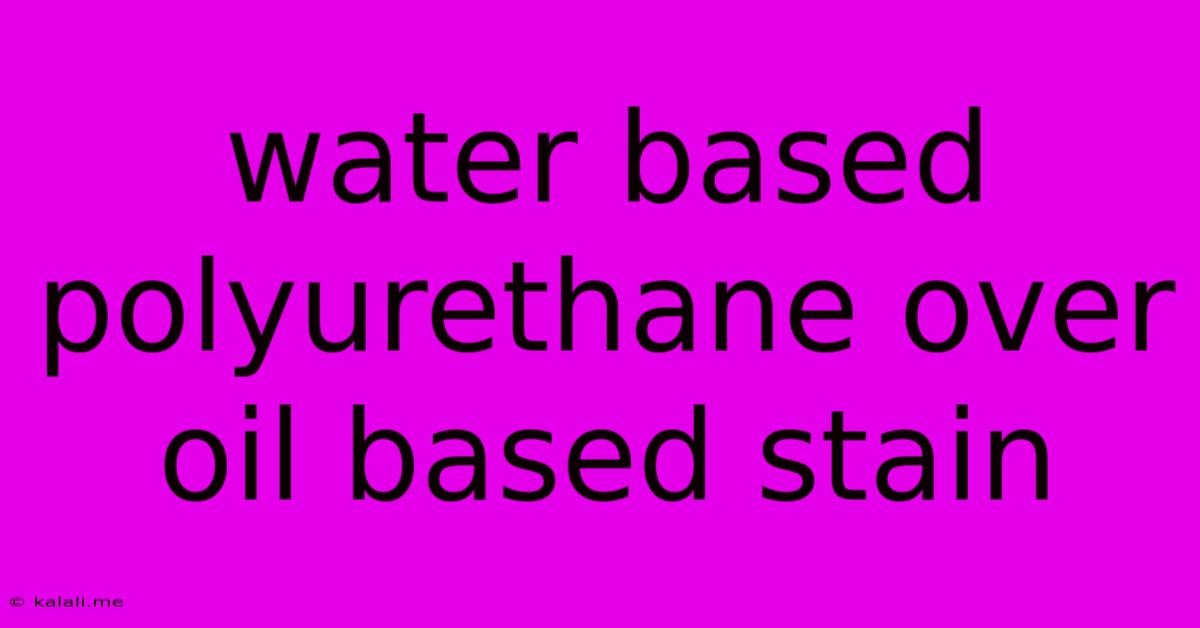Water Based Polyurethane Over Oil Based Stain
Kalali
May 23, 2025 · 4 min read

Table of Contents
Can You Put Water-Based Polyurethane Over Oil-Based Stain? The Definitive Guide
Meta Description: Wondering if you can apply water-based polyurethane over oil-based stain? This guide clarifies the compatibility, potential issues, and best practices for achieving a durable and beautiful finish. Learn about preparation, application techniques, and troubleshooting tips for success.
Applying a protective topcoat over your stained wood is crucial for longevity and beauty. But what happens when you’ve used an oil-based stain and now want to use a water-based polyurethane? The short answer is: it's possible, but requires careful preparation and understanding of the potential challenges. This article dives into the specifics, outlining the process and offering advice to ensure a successful finish.
Understanding the Compatibility Challenge
The main issue stems from the fundamental differences between oil-based and water-based products. Oil-based stains penetrate the wood deeply, creating a rich, saturated color. They cure through oxidation, a slow process that forms a hard, durable surface. Water-based polyurethanes, conversely, cure through evaporation and are generally faster-drying. The problem lies in the potential for the water in the polyurethane to react with the oil in the stain, leading to several problems:
- Lifting or bubbling: The water in the polyurethane can emulsify the oil-based stain, causing it to lift or bubble up from the wood's surface.
- Poor adhesion: If the stain isn't fully cured or properly prepared, the polyurethane may not adhere well, resulting in peeling or chipping over time.
- Muddy or uneven finish: The interaction of water and oil can create a cloudy or uneven appearance on the final finish.
Preparing for Success: A Step-by-Step Guide
To minimize these risks, meticulous preparation is paramount. Follow these steps for the best results:
-
Allow Ample Curing Time: Ensure your oil-based stain is completely cured. This usually takes several days, but check the stain's manufacturer's instructions for the recommended drying time. The longer you wait, the better.
-
Clean the Surface: Remove any dust, debris, or excess stain from the wood surface. Use a tack cloth for thorough cleaning. A clean surface is essential for proper adhesion.
-
Light Sanding (Optional): Lightly sanding the stained surface with fine-grit sandpaper (220-grit or higher) can help improve adhesion. This step is optional, but it can be beneficial. However, avoid aggressive sanding, as this can remove the stain.
-
De-glossing: If the stain is very glossy, you can lightly de-gloss it with a fine-grit sandpaper or a liquid deglosser. This creates a more receptive surface for the polyurethane.
-
Test in an Inconspicuous Area: Before applying the polyurethane to the entire piece, test it on a small, hidden area to check for any reactions or incompatibility issues.
Applying the Water-Based Polyurethane
Once the preparation is complete, apply the water-based polyurethane according to the manufacturer's instructions. Typically, this involves:
- Thin Coats: Apply thin, even coats to avoid runs or drips. Multiple thin coats are better than one thick coat.
- Proper Ventilation: Ensure adequate ventilation to allow the polyurethane to dry properly.
- Drying Time: Allow sufficient drying time between coats, as specified by the manufacturer. This typically involves several hours, but you should always check the product label.
- Sanding Between Coats (Optional): Lightly sanding between coats with very fine sandpaper (320-grit or higher) can create a smoother, more even finish. However, this step is often not necessary if your application is even.
Troubleshooting and Potential Issues
Despite careful preparation, you might encounter some challenges. Here are some troubleshooting tips:
- Bubbling: If bubbling occurs, it's likely due to insufficient curing time of the stain or moisture trapped beneath the surface. Sand down the affected areas and reapply the polyurethane.
- Poor Adhesion: If the polyurethane peels or chips, it indicates poor adhesion. Check to make sure the stain was thoroughly cured and the surface was properly cleaned.
- Uneven Finish: Uneven application is the most common cause of an uneven finish. Ensure even coats and proper drying time.
Conclusion
While applying water-based polyurethane over oil-based stain is achievable, it requires patience, careful preparation, and attention to detail. By following these guidelines, you can significantly increase your chances of achieving a durable and beautiful finish on your woodworking project. Remember to always prioritize thorough preparation and testing before proceeding with the full application.
Latest Posts
Latest Posts
-
Efi Variables Are Not Supported On This System
May 23, 2025
-
Where Would User Credentials Be Stored In Ros Linux
May 23, 2025
-
How To Know How Many Zeroes A Trig Function Has
May 23, 2025
-
Whats It Called To Have Four Arms
May 23, 2025
-
Ceiling Fan Light And Fan Not Working
May 23, 2025
Related Post
Thank you for visiting our website which covers about Water Based Polyurethane Over Oil Based Stain . We hope the information provided has been useful to you. Feel free to contact us if you have any questions or need further assistance. See you next time and don't miss to bookmark.